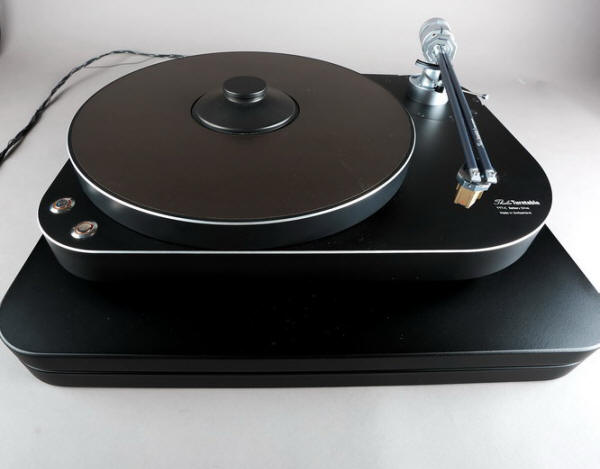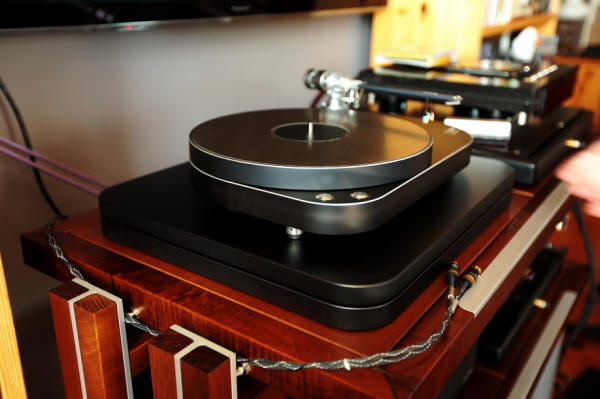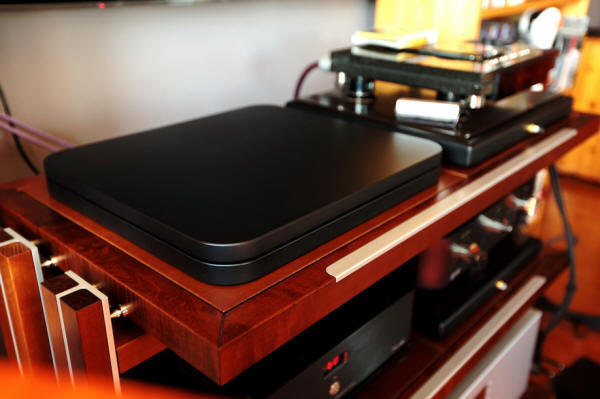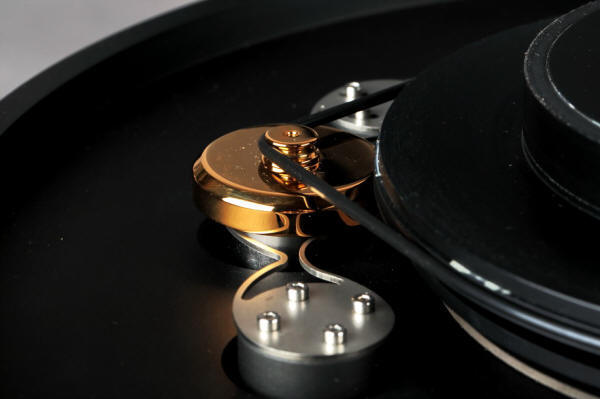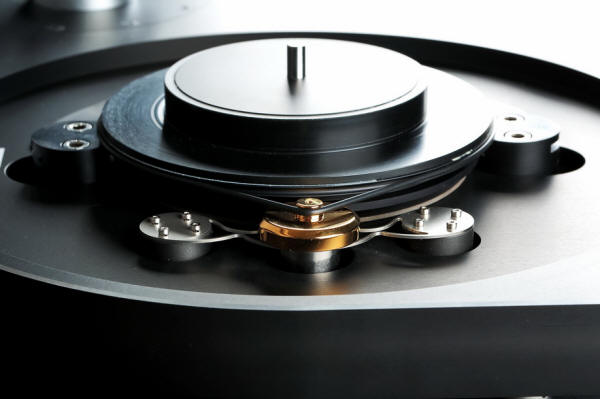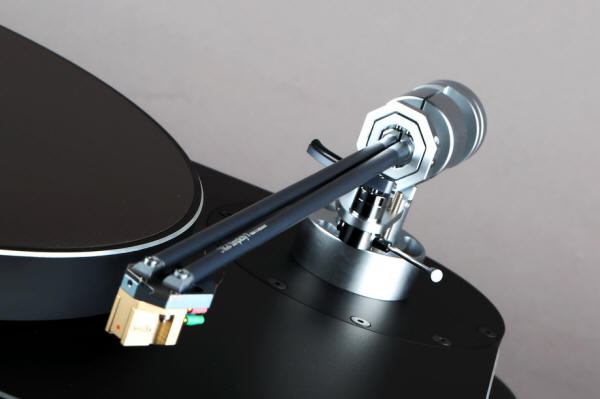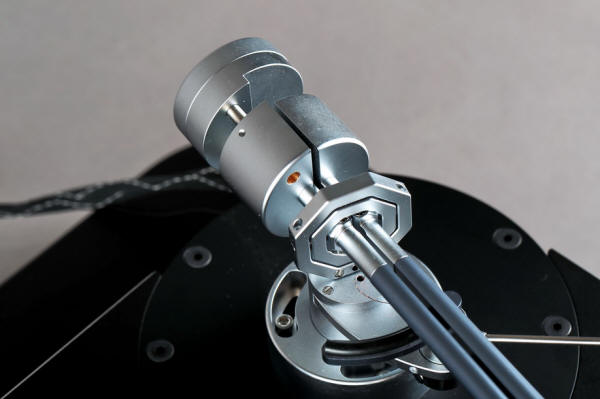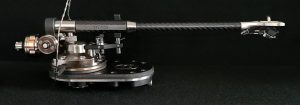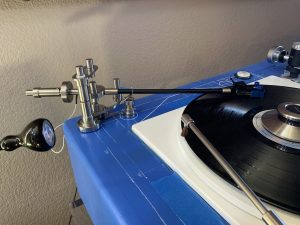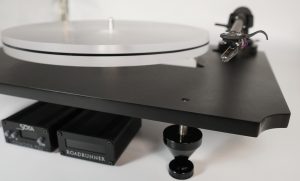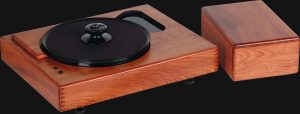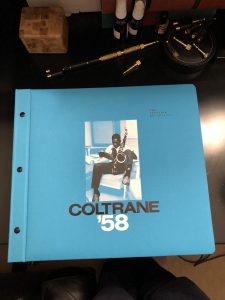The Air Force One turntable from the Japanese manufacturer TechDAS that I reviewed in March was a true revelation to me and its presence in my system (see HERE) made for an exceptional experience. It embodies all the design concepts of Mr. Hideaki Nishikawa, his whole experience and heaps of money from the Japanese company Stella, which owns the TechDAS brand and paid for everything. The AFO design and built quality is outstanding and it employs some interesting design solutions, like its vacuum hold-down system, air-bearing to "float" the platter, and others. But if you look objectively at this manifestation of the human spirit, which is how I understand audio, while being aware of its perfection it will be difficult to point out things that could be called "breakthrough", "one of its kind", "changing the paradigm". Although such level of precision and such design consequence as here, combined with such accumulation of engineering knowledge are in themselves "one of its kind", their unique status is based on countless minor improvements of concepts that have long been known, discussed and used by many other manufacturers.
True innovations are extremely rare in the world of analog audio. Passing over magnetic tape, the basic principles of turntable and tonearm design were known decades ago and have since only been polished and refined. Hence, a revolutionary tonearm design concept introduced by the Swiss company Thales was very refreshing.
Its inventor is Micha Huber—mechanical engineer, musician and watchmaker. The concept is based on school geometry and makes use of Thales' theorem (Thales' Circle). The idea was patented (694567 CH) as Tangential Pivoted Tonearm and showcased to the world in May, 2004.
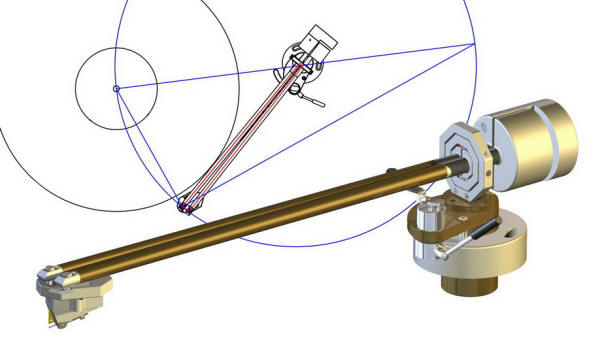
The Thales Original tonearm, which was based on this theory, came with one sole objective: to reduce tracking errors to absolute minimum while avoiding the problem of tangential arms, i.e. a large difference in the vertical and horizontal effective mass. All pivoted tonearms exhibit distortion resulting from the fact that LP masters are cut tangentially.
The Swiss arm looked like a classic pivoted design but, on the other hand, it featured innovative, unusual additional components. While the arm had a classic look, the gimbal bearing looked different than usual. An additional horizontal and vertical arm were used to rotate the headshell as it moved towards to the disc center to mimic the tangential arm movement and keep the cartridge tangent to the groove for zero tracking angle error. A rather complicated description, but one look at the picture is enough to know what it's all about.
The Original arm was very expensive and not suitable for use with every turntable. The latter restriction prompted the development of a more compact arm that was, somewhat tongue-in-cheek, called the Simplicity. The arm can be mounted on any turntable. Tracking geometry is based on a tetragon design with two arm tubes instead of one, moving relative to each other. Thales claims to have achieved a vanishingly low tracking error of 0.008°. The arm length is 9" and its effective mass is 19 grams. The arm is suspended in a gimbal assembly equipped with six ruby bearings. The arm can be ordered in three finish colors and a choice of DIN, RCA or XLR connectors.
The tonearm that was sent for a review is the second revision of the Simplicity design. Compared to the MkI, ruby bearings have been abandoned in favor of miniature ball bearings, the tonearm lift is mounted slightly differently and azimuth adjustment mechanism is more accurate. Internal arm wiring is now run differently compared to the first version.
Thales is a company whose founding idea was an innovative tonearm design. It soon turned out that in order to maximize its benefits and advantages as planned, it was necessary to design an own turntable. This led to the development of the battery-powered TTT-Compact.
The name perfectly describes its body—it is small and graceful and makes no impression of being massive, and therefore expensive. A perfect turntable for those who do not want other family members to know how much they spent on another "toy".
This is not the only example of a small, expensive and advanced turntable design. We must also recall the earlier designs—the SG1.1 from Spiral Groove and products from Simone York. But the TTT-Compact is the only battery powered design in this group. The turntable comes with the proprietary air-decoupled LEVI-Base board.
The turntable was installed in my place by Wojtek from RCM, a real pro when it comes to THESE things. I wish everybody such great customer service, with every step so well thought out. It was him, together with Roger, the owner of RCM, who decided to equip the turntable with the Shelter 7000 cartridge. It is an MC cartridge with 0.55mV output voltage. In the RCM phono stage that I used, I set the nearest corresponding value of 0.4mV. The next value of 0.6 mV seemed slightly too bland. The manufacturer quotes the load impedance of 100 ohms; I settled for 200 ohms and it was perfect. The cartridge comes with a 0.3 x 0.7mm elliptical nude diamond stylus. Tracking force has a very wide range, from 1.4 to 2 grams; Wojtek set it to 1.8 gram. The cartridge coils use PC-OCC copper wire. The cartridge looked great on the Simplicity II arm, as if the two had been designed together.
SOUND
Albums auditioned during this review
• Ben Webster, Old Betsy - The Sound Of Big Ben Webster, STS Digital STS 6111129, 180g LP (2013).
• Depeche Mode, Leave In Silence, Mute 12 Bong 1, 12" single (1982).
• Dominic Miller, 5th House, Q-rious Music/Rutis Music QRM 122-2, 180g LP (2012).
• Dominic Miller, Fourth Wall, Q-rious Music/Rutis Music QRM 114-2, 2 x 180g LP (2010); reviewed HERE.
• Gerry Mulligan & Thelonious Monk, Mulligan meets Monk, Riverside/Analogue Productions AJAZ 1106, "Top 20 Jazz, 45 RPM Limited Edition #0584"2 x 180g, 45 rpm LP (1957/2009).
• Harbie Hancock, Takin' Off, Blue Note/Cisco Music CLP-7050, "Limited Edition S/N 0692", 180g LP (1962/2006).
• JS Bach, Partitas, Florin Paul, Tacet L 10, 2 x 180g LP (2012).
• Marek Biliński, Best of the Best, Bi.Ma. BiLP-01, 180g LP (2014).
• Metallica, Master Of Puppets, Asylum Records/Warner Bros. 470908-1, "45 RPM Series", 2 x 180g LP (1986/2008).
• Miles Davis, Miles Davis and The Modern Jazz Giants, Riverside/Analogue Productions AJAZ 1106, "Top 100 Jazz, 45 RPM Limited Edition #0706, 2 x 180g, 45 rpm LP (1956/?).
• The Montgomery Brothers, Groove Yards, Riverside/Analogue Productions AJAZ 9362, "Top 100 Fantasy 45 Series", 45 rpm, 180g, 2 x LP (1961/?).
In audio, and in the turntable department especially, product design and built quality determines the set of its sonic characteristics that we run into when listening to music. In other words, seeing how the product is built, we can say with high probability what kind of modifications it will bring to the sound. Sometimes, as in the case of the Thales turntable, it remains an unpredictable puzzle. Taking into consideration other turntables, it would have to be described as a light, non-decoupled, belt-driven design. The arm remains beyond the scope of our guess, because no other company offers this type of design. One could therefore presume that the TTT-C equipped with the Simplicity MkII will offer a precise, selective and resolving sound. The tonal balance would solely depend on the designers' choices. It might be rather high, as in turntables from Thorens and Clearaudio (light). It could also be low, as in inexpensive Pro-Ject designs, where the treble is recessed and rounded, bringing the warm midrange to the foreground. In a sense, similar comments could be made about Rega turntables, except that they show a more active treble.
None of these guesses works with the Thales, and will be completely off the mark. The first thing that comes in as a shock—and it's not a figure of speech—is the depth, focus and density of bass. Something like that is offered by advanced, mass loaded turntable designs, such as Transrotor, or specially adjusted and also quite heavy units, like SME. The Thales sounds even denser and more dynamic from all of them. As if dropping heavy mass that colors the mid-bass has cleared, refined and polished it.
Perhaps it is somewhat "made up" because the bass now shows up on the albums where it was previously lacking or seemed absent altogether, such as on the 45 RPM re-release of Metallica's Masters of Puppets. Albums with plenty of well-recorded bass, there was fire. Depeche Modes maxi-single Leave in Silence, which sent shivers down my spine on the Air Force One, now sounded even a bit more dynamic, the attack transient a little stronger and stiffer. No contouring or hard edge whatsoever, no way, Jose; but the physical impression of bass punch was greater with the Swiss turntable.
But the thing is not just about the intensity and deep extension. The Thales system, as it is both a turntable and tonearm (though I suspect the latter to a greater extent), shows the bass in such a clean way like no other turntable, except perhaps the said Air Force One. But it was only the Swiss machine that let me hear the low frequency distortion that occur on many records, especially at the beginning of the disc. What I mean is the kind of low bass modulations that other turntables do not "hear". This shows that the Thales has incredibly low distortion and, in a way, it brings the music one step closer to the listener.
After all, it's not all about bass. This is a dense, focused sound. The kind we sit back, relax and chill out to, without falling asleep. The beauty of vinyl, irresistible with many a turntable, is truly enchanting with the Thales. It makes each disc sound interesting, even those worst recorded, even as battered as my copy of Isabella Trojanowska's debut album with Budka Suflera, with the track "I am your sin" almost completely worn out by the previous owner. The LP was marked Excellent+ when I bought it and it was really clean, almost with no scratches. It was evident that the previous owner had been taking care of it. What you couldn't see was how much it was worn out, presumably by lesser quality audio equipment. It only came out during playback. The track I've referred to ends the disc, hence it falls in the area of the lowest speed, which translates to highest distortion with classical tonearms. Add to that pops and clicks and it spells disaster.
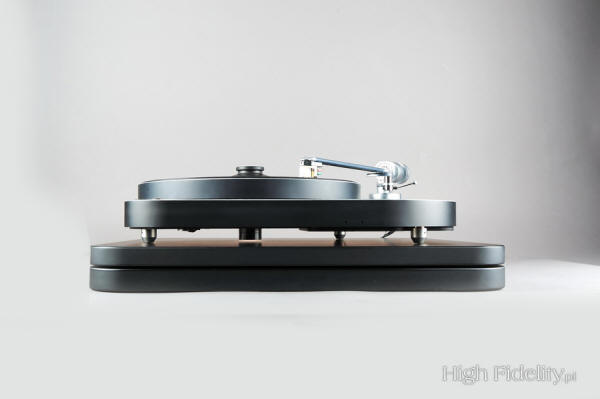
The Thales did not improve anything—the pops were still there, as always. What it did, however, was to pitch them next to a dense, low balanced sound, music. That the best turntables put natural vinyl distortion, like pops and surface noise, "outside" music presentation is something absolutely normal. What it means is that the distortion is heard from a different sonic plane and does not interlock with the sound, even though it comes from the same speakers. It is as if we stood in a room where music is played back from the speakers and live instruments at the same time. These are two different realities, which we understand instinctively.
The Thales did all that in a very natural, stress-free manner. Intuitively. It added to that the saturation of basic sound, its coherence and density. It made the kind of distortion that were the reason many people had long given up on vinyl even less interfere with the music.
On this system, resolution and selectivity are one and the same. Wonderfully combined and supporting each other. The sound of violin, recorded with two microphones, horn equipment and reel to reel tape recorder, was captivating in its beauty. I played this CD to a few people and each one of them was moved by what they heard. The term that everyone used to describe it was "beautiful." Even though it's a single instrument, the volume of sound was big, and the space in which it had been recorded was supporting the basic sound. Density and focus went smoothly hand in hand.
The turntable did not cover recordings' problems. The Sisters of Mercy remasters from a digital tape remained as they were, showing poorly differentiated and sometimes slightly distorted treble. The Thales had no problem with this kind of problems. They were audible, but somehow easy to ignore, so to speak. The presentation was so vivid and engaging that they were but minor inconveniences, like small bumps on the highway while driving a comfortable limousine.
Conclusion
When I receive another cool source for a review and I share this information with my friends, they no longer ask about the product itself but rather whether it has any chance to stand up to the Air Force One, my dream machine from TechDAS. My answer is the same: Ha, ha, ha! Typically, there's more "ha". Such is life. But it's also true that the Japanese turntable is the absolute top for me and it's very hard to get there.
The Thales is not a product of the same caliber, either. At the same time, however, it is one of the few turntables I could live with as a temporary replacement for the AFO (and while waiting for the Japanese). They both share a similar approach to the musical material. It's an open, resolving and dense sound with fantastic bass and great dynamics. The sound is well differentiated from disc to disc, often within the same disc, and yet there is a kind of "protective umbrella" over each recording, which makes us pass over the issue of their recording and pressing quality, and instead concentrating primarily on the music. The impression is all the more pronounced with quality pressings, such as 45 RPM versions from Analogue Productions, discs from Speakers Corner or good originals. But even inferior versions or discs in poorer condition are not disqualified and I reached for them with equal pleasure as for the refined 180g/45 RPM/one side reissues.
What the Thales is not capable of doing equally well as the TechDAS machine is presenting the instruments so phenomenally independent of one another, while showing the interlinked connections between the musicians and acoustics. The AFO plays everything even more softly, better showing the contours and textures. And space—the Japanese turntable does something incredible to it, which makes many recordings sound much better than live concerts. The Thales is also great at that sort of thing, but apparently there are just limits to what it can do.
But there is something no other turntable that I've heard can offer: the sound we get from such a small form factor is similar to what we hear from big, massive turntables full of technological innovations and design solutions. The Thales may be small but its sound is like a dream.
DESIGN
The Thales brand is owned by a Swiss company HiFiction AG, located in Winterthur. The company is a specialist manufacturer of precision turntable components and assemblies. It combines modern technologies such as CAD, micromechanical components assembly and surface treatment with traditional hand craftsmanship. In May 2012, the company moved to the third floor of a large industrial building in Hegi, with plenty of space for its R&D department, prototype and assembly room. All this information is important to understand the incredible level of precision that goes into the manufacturing of the TTT-Compact and Simplicity II.
TTT-Compact
The base is tiny and at first glance we can't quite see what we pay for. And we pay, among other things, for the battery power supply for the motor. Seeing a high-end turntable we can be hundred percent sure to see next to it a big power supply enclosure. The point is to "translate" the AC mains power to a perfectly clean current to power the motor. It is not necessary in the case of the TTT-C, as it is guaranteed by the very nature of battery power. Four LiFePo batteries and a charging circuit are housed in the cutout in the very low base. Fully charged batteries provide 16 hours of continuous operation. An operating mode switch on the back is used to put the unit into charging, standby or playback mode. Adjacent to it is a small socket for the outboard 13.2V DC power supply. The latter should be disconnected during playback. The speed (33.3 or 45 RPM) is select via two switches in the left front corner. Fine speed adjustment are possible using small potentiometers available through tiny holes in the front. The 20W DC motor is a modern brushless design.
The small motor is mounted to a relatively rigid decoupling component. The motor pulley is very close to the sub-platter, because the designers wanted the drive belt to be as short as possible. The belt is made of a special material used in medical applications. The whole drive assembly is carefully calculated and designed for the lowest possible vibration and minimal axial movement of the motor.
The main bearing is Most proud of the company is, however, self-designed main bearing. The main shaft (spindle) is made of hard chrome-plated carbon tool steel with hand polished surface. The shaft runs in two sintered bronze bushings. Sintering is the process of forming solid materials by heat and pressure without melting it to the point of liquefaction. This gives the material high purity and very high mechanical resistance. Sintered bronze is frequently used as a material for bearings due to its porosity that allows lubricants to remains captured within it. The bushings are soaked in a specially prepared oil. The platter spindle ends with a small spherical carbide piece that rests on a hardened steel ball. The whole bearing assembly is enclosed in a heavy ductile cast iron housing. The material has excellent vibration damping characteristics.
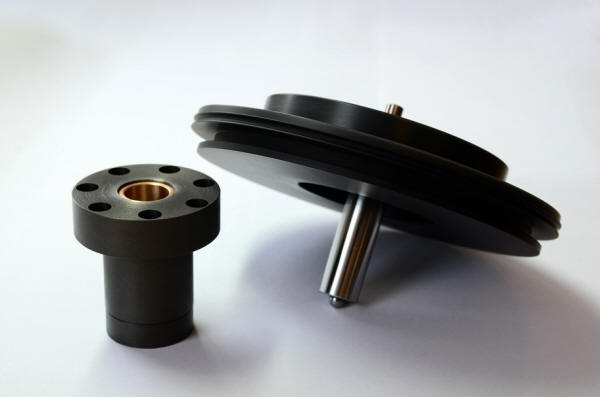
The turntable platter has two main objectives: to increase the rotating inertial mass and to provide a good support for the vinyl disc. In the TTT-C, the platter mass is not too high but it is intelligently used. The platter weighs 6.5kg but the mass is concentrated at its outer perimeter. This gives the equivalent inertial properties of a 8kg platter. The platter is tuned to a single resonant frequency, which is damped by a customized high density inlay. It feels like rubber to the touch, but of a different consistency. The inlay also serves as a record mat. The record is hold down by a 460g brass record clamp. Its underside is covered with the same mat as the platter surface.
The whole unit rests on three small feet. While they look simple from the outside, they are actually a smaller variant of isolation feet offered by Finite Elemente. They are composed of two main metal parts, the base and top cap, separated by a ball, held in place by a rubber O-ring around the shaft of the base. The whole sits on the LEVI-Base pneumatic board, whose design resembles the RAF-48H air board that I have been using in my system for several years. The TTT-C can also be equipped with a second tonearm, which needs an optional arm base.
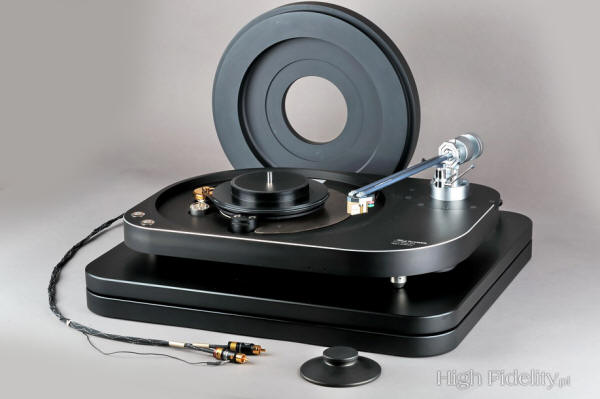
Simplicity II
Thales' career began with its tonearm design, which distinguishes it from almost all other manufacturers, except for SME. Manufacturers usually start with a turntable, which is relatively easier to design, and then add to it an own tonearm (or not). Here, the idea was simple: to design a classic gimbaled tonearm that would have the advantages of tangential arm, which is to keep the cartridge tangent to the groove for zero tracking angle error all the way. The way it has been executed in the Simplicity II is that there are two parallel arm tubes, connected with a special gimbal bearing on one end and head piece bearings on the other. The tracking geometry is based on a unique tetragon solution. It may sound simple, but the design and craftsmanship has to be perfect for it to work. The counterweight is divided into two pieces for optimized energy flow so each arm tube has its own counterweight. An additional eccentric piece can be attached to ensure constant tracking force across the record surface. Three different counterweight are included to balance a wide range of cartridges (between 7 and 23g). The company claims to have reduced the Simplicity II tracking error to a negligible 0.006°. For clarity: the tracking error in a classic 9" tonearm can reach 2.5° and is down to 2° in the best 12" arms.
As I have mentioned before, the company replaced ruby bearings with ball bearings. Thales used a new technology, called TTF (Thales Tension Free) bearing technology, which has been in development since 2012. In a nutshell, it combines the benefits of traditional ruby bearings (damping properties, a single point of contact and angular alignment) with those of the ball bearing (high resistance load). The TTF technology allows to achieve an extremely low coefficient of friction, complete absence of backlash and, as a side effect, an integrated shock absorbing system.
The arm features Thales' own pure copper internal wiring. In the previous arm version, the wires were twisted together and run in one of the arm tubes. Now each channel is run separately. The cables are terminated with a DIN or RCA connector, per customer's request. An interconnect is not included but can be purchased separately from Thales. The review was conducted with the Thales interconnect.
The quality of workmanship of each component is well above average and may be called perfect. But what else could be expected from the descendants of the best watchmakers in the world?
Technical Specification (according to the manufacturer)
• Speed: 33⅓ rpm, 45 rpm
• Wow & flutter (at 33⅓ rpm, DIN45 507): ± 0.06%
• Rumble: -60dB (unweighted)
• Output: RCA / XLR / Direct
• Weight: 16kg
• Dimensions: 432 x 312 x 91mm
• Battery life: 16h
Pricing (in Poland): 43,400 PLN + 8,250 PLN + 31,900 PLN
HiFiction AG
Micha Huber | Stäffelistrasse 6
CH-8409 Winterthur | Switzerland
tel.: +41 52 202 43 12 | [email protected]
www.tonarm.ch
MADE IN SWITZERLAND
Product provided courtesy of: RCM
text by Wojciech Pacuła, images by Wojciech Pacuła and Thales, translation by Andrzej Dziadowiec




